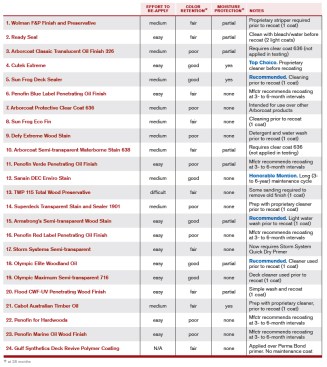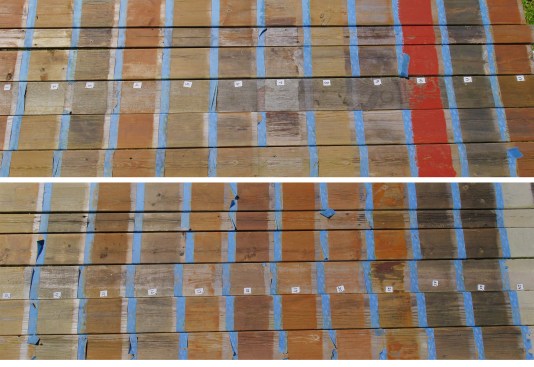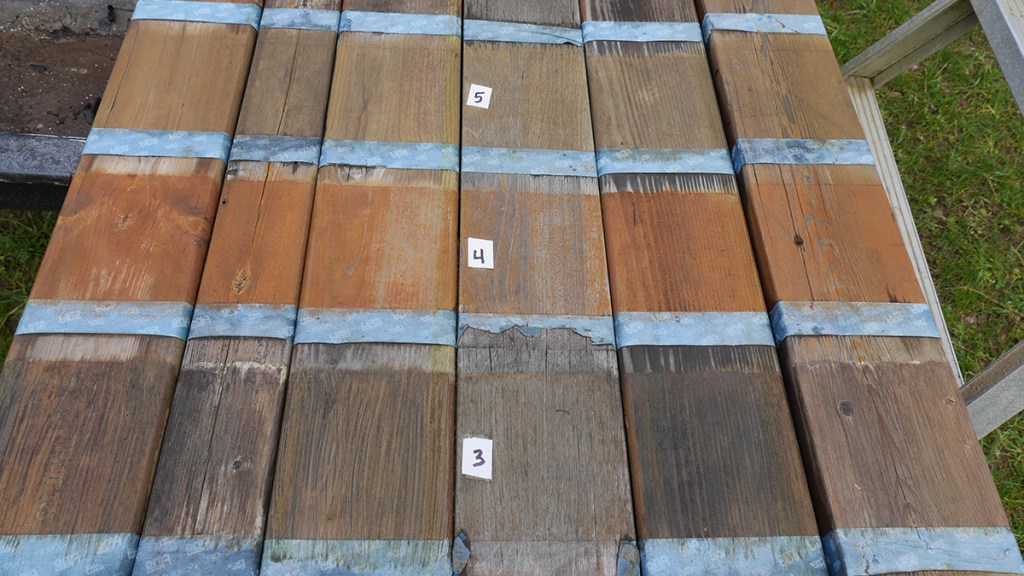In October 2014, we began a test of two-dozen different deck finishes. Our goal? To find out if any of them were tough enough to stand up to the daily abuse that gets heaped on wood decking. We explained our methodology and reported on our nine-month observations in “The Great Stain Shoot-Out,” which was published in the October 2015 issue of PDB. We are now two and a half years into the trial—plenty of time for the elements to do their worst—and are ready to draw a few final conclusions (see chart).
A Second Chance
In our first report, we were disappointed to find that the majority of the wood finishes we were testing didn’t seem to be holding up very well, even without the normal foot traffic that a deck would get. Still, we gave high marks to Sansin Dec Enviro Stain, Wolman F&P, and Cutek Extreme, all of which showed good color retention and little or no mold growth across all six species of wood in our test. Because of its ease of application, we selected Cutek Extreme as our overall best pick—and then resumed our testing.
After we recorded our observations in July 2015 for our first report, we prepped the boards for recoating, following each stain manufacturer’s recommendations. As we noted in our previous article, most of the test boards needed to be at least scuff-sanded before being refinished; a few needed only to be cleaned off before the stain could be reapplied.
Then we recoated the boards, again applying the finish according to the manufacturer’s recommendations. Most of the manufacturers recommended only a single coat, but a few recommended two coats of finish; where they did, we noted it on our chart. Many of the finishes had already failed by this point, so the arduous sanding and refinishing significantly freshened up the look of the decking.
Then we waited while Mother Nature did her thing. Here in Olympia, where we conducted our testing, we don’t have temperature extremes—the average high temperature in summer is 80°F, with only a handful of days rising into the upper 90s, while the average low temperature in the winter is 32°F, with a few days dipping into the teens. But we do get a lot of rain: During the rainy season, from October through May, a deck can stay wet for weeks or even months. However, the winter of 2015–2016 was one of the driest we’ve ever seen, so it was less wet and more sunny during this part of our testing period than we had expected it would be.

In July 2016 (one year after recoating), we checked our samples to see how well the finishes were holding up. But we didn’t restain the boards; we wanted to see what happens when the mandatory annual maintenance routine is skipped.
Results
On a sunny, spring-like day seven months later in March 2017, after 28 months of exposure to western Washington’s drizzly rain and summer sun, we thoroughly reviewed all the boards again. We graded each sample’s general appearance, looking specifically at color retention and weathering. We also were interested in comparing how much moisture protection the finishes were providing to the wood.
In the first round of testing, we had used a moisture meter to measure moisture content, as well as informal rain-shower testing, to evaluate how well each finish repelled water. This time, we omitted the moisture meter, since it didn’t seem to show much correlation between water-beading ability and the actual moisture content in our samples.

Here is how the finishes fared on each type of wood decking after 28 months of exposure. From top to bottom in both photos, the decking is micronized-CA-treated southern yellow pine; well-seasoned western red cedar; lodgepole pine; ipe; ACQ-treated southern yellow pine; and seasoned ACQ-treated hem-fir decking. The numbers on the decking can be used along with the chart to identify each finish.
Generally speaking, we determined that if water droplets remained on the decking surface 30 minutes after being exposed to rain, the finish was still offering a reasonable amount of protection. If the water droplets had disappeared and the wood was dry on the surface, we figured that the finish wasn’t preventing the wood from absorbing the moisture.
As in our first round of testing, at the nine-month mark, Sansin Dec Enviro Stain still offered the best color retention across all six types of wood decking, though this might be attributable to the fact that we applied two coats of the finish (per the instructions). Cutek Extreme looked almost as good, but seemed to provide better moisture protection; we found that water still beaded up on decking finished with Cutek, but not on the boards finished with Sansin. Curiously, Sun Frog Deck Sealer offered good color retention when it was dry, but seemed to lose its color when wet.
Other finishes that offered good color retention were Armstrong’s Semi-transparent Wood Stain, Olympic Elite Woodland Oil, and Olympic Maximum Semi-transparent Stain.
The three finishes that seemed to provide the best moisture protection were Cutek Extreme, followed by Cabot Australian Timber Oil Natural, and Sun Frog Deck Sealer.
Based on our testing, our overall first choice for a wood deck finish is Cutek Extreme, thanks to its easy application, good color retention and moisture protection, and suitability for use on green lumber. Sansin Dec Enviro Stain earns a solid honorable mention; we’ve been using it for 20 years with good results. Our next three choices would be Sun Frog Deck Sealer, Armstrong’s Semi-transparent Wood Stain, and Olympic Elite Woodland Oil.
